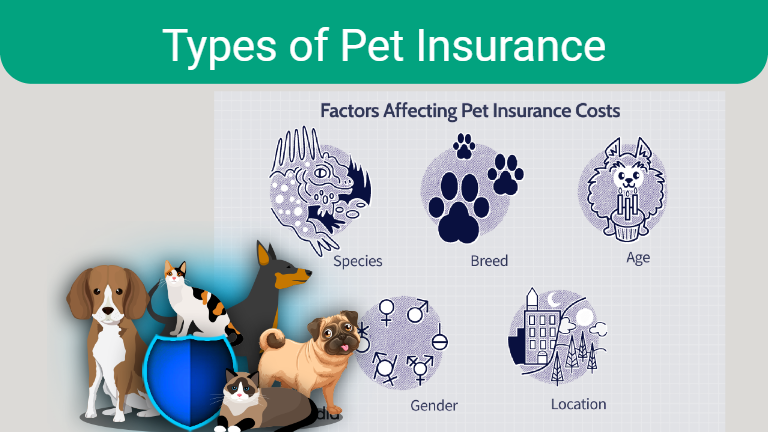Pets are beloved members of our families, bringing joy, companionship, and unconditional love into our lives. As pet owners, ensuring their health and well-being is a top priority.

Veterinary care can be expensive, especially in the case of unexpected illnesses or accidents. Pet insurance for dogs and cats is a valuable tool that provides financial protection and peace of mind, allowing you to make the best healthcare decisions for your furry friends without worrying about the cost. This article explores the different types of pet insurance, their benefits, and tips for choosing the right policy.
Types of Pet Insurance

1. Accident-Only Insurance
Accident-only insurance covers veterinary expenses resulting from accidents such as broken bones, cuts, burns, and poisonings. This type of policy does not cover illnesses or routine care.
Benefits:
- Affordable Premiums: Accident-only policies typically have lower premiums compared to comprehensive plans.
- Basic Coverage: Provides financial protection for unexpected injuries and emergencies.
Considerations:
- Limited Coverage: Does not cover illnesses or preventive care.
- Out-of-Pocket Costs: You will still be responsible for routine veterinary expenses and treatments for illnesses.
2. Illness Insurance
Illness insurance covers veterinary expenses related to a wide range of illnesses, from minor infections to major diseases such as cancer or diabetes. It does not cover accidents or routine care.
Benefits:
- Extensive Coverage: Covers a broad spectrum of illnesses, providing financial protection for various medical conditions.
- Peace of Mind: Ensures you can afford necessary treatments for your pet’s health issues.
Considerations:
- Higher Premiums: Illness insurance premiums are typically higher than accident-only policies.
- Exclusions: Pre-existing conditions and certain hereditary or congenital conditions may not be covered.
3. Comprehensive Insurance
Comprehensive insurance, also known as accident and illness insurance, combines coverage for both accidents and illnesses. This type of policy offers the most extensive protection for your pet.
Benefits:
- Complete Coverage: Provides financial protection for a wide range of accidents and illnesses.
- Versatile Protection: Covers most medical expenses, ensuring you can provide the best care for your pet.
Considerations:
- Higher Premiums: Comprehensive policies have higher premiums due to their extensive coverage.
- Policy Limits: Some policies may have annual or per-condition limits on payouts.
4. Wellness and Preventive Care Add-Ons
Wellness and preventive care add-ons can be added to an existing pet insurance policy to cover routine care expenses such as vaccinations, flea and tick treatments, dental cleanings, and regular check-ups.
Benefits:
- Routine Care Coverage: Helps manage the costs of preventive care and routine veterinary visits.
- Improved Pet Health: Encourages regular veterinary visits and preventive care, promoting overall health.
Considerations:
- Additional Cost: Adding wellness coverage increases the overall premium.
- Coverage Limits: There may be limits on the amount reimbursed for specific preventive care services.
Small Business Liability Insurance: A Comprehensive Guide
Long-Term Disability Insurance Options: Securing Your Financial Future
Benefits of Pet Insurance
1. Financial Protection
Pet insurance provides financial protection against the high cost of veterinary care, especially for emergencies, surgeries, and chronic conditions. It allows you to focus on your pet’s health without worrying about the financial burden.
2. Access to Quality Care
With pet insurance, you can afford to seek the best possible care for your pet. You won’t have to compromise on treatment options or delay necessary procedures due to cost concerns.
3. Peace of Mind
Knowing that you have insurance coverage for your pet’s medical needs gives you peace of mind. You can rest assured that you can handle unexpected veterinary expenses and provide the best care for your furry friend.
4. Flexibility in Treatment Decisions
Pet insurance gives you the flexibility to choose the best treatment options for your pet without being constrained by financial limitations. You can opt for advanced treatments and specialist care if needed.
5. Budget Management
By spreading the cost of veterinary care through monthly insurance premiums, you can better manage your budget and avoid sudden, large expenses due to unexpected medical issues.
Tips for Choosing the Right Pet Insurance Policy
1. Assess Your Pet’s Needs
Consider your pet’s age, breed, health status, and lifestyle when choosing an insurance policy. Some breeds are prone to specific health issues, and older pets may require more medical care.
2. Compare Coverage Options
Compare policies from different insurance providers to find the best coverage for your pet. Look at what each policy covers, including accidents, illnesses, and routine care, and compare exclusions and limitations.
3. Check for Exclusions and Limitations
Review each policy’s exclusions and limitations carefully. Some policies may exclude pre-existing conditions, hereditary or congenital conditions, or certain types of treatments.
4. Understand Reimbursement Policies
Understand how the insurance provider reimburses claims. Some insurers reimburse a percentage of the vet bill, while others have fixed benefit schedules. Check if there are annual, per-incident, or lifetime limits on payouts.
5. Consider Deductibles and Premiums
Evaluate the policy’s deductibles and premiums to ensure they fit within your budget. Higher deductibles usually result in lower premiums, but you’ll need to pay more out of pocket before coverage kicks in.
6. Look for Waiting Periods
Be aware of any waiting periods before coverage begins. Most policies have waiting periods for accidents and illnesses, and these can vary by provider.
7. Read Customer Reviews
Read reviews and testimonials from other pet owners to gauge the insurance provider’s reputation for customer service, claim processing, and overall satisfaction.
8. Consult Your Veterinarian
Consult with your veterinarian for recommendations on pet insurance providers and policies. They can provide insights based on their experience with different insurers and help you choose a policy that meets your pet’s needs.
Conclusion
Pet insurance for dogs and cats is an invaluable investment in your pet’s health and well-being. By understanding the different types of coverage available and carefully considering your pet’s specific needs, you can choose a policy that provides the best protection for your furry friend. With the right pet insurance in place, you can ensure that your beloved companion receives the best possible care, no matter what unexpected health challenges may arise.
Affordable health insurance plans
Renters Insurance for College Students: Protecting Your Belongings and Peace of Mind
Pet Insurance for Dogs and Cats: Protecting Your Furry Friends
Best Life Insurance Policies for Families: Securing Your Loved Ones’ Future